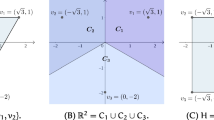Abstract
In this paper, the following problem is considered: for a given nondecreasing finite sequence of positive integers, determine if there exists an affine control system whose growth vector coincides with this sequence. The answer is “yes” if and only if the Taylor series of a certain function constructed via elements of the sequence has nonnegative coefficients. It turns out that this problem is closely connected with properties of “core Lie subalgebras” of affine control systems which are responsible for a homogeneous approximation. We give a representation of core Lie subalgebras as free Lie algebras and describe sets of all possible core Lie subalgebras for systems with a fixed growth vector.
Similar content being viewed by others
References
A. A. Agrachev, R. V. Gamkrelidze, and A. V. Sarychev, Local invariants of smooth control systems. Acta Appl. Math. 14 (1989), 191–237.
A. A. Agrachev and A. Marigo, Nonholonomic tangent spaces: intrinsic constructions and rigid dimensions. Electr. Res. Ann. Amer. Math. Soc. 9 (2003), 111–120 (electronic).
_____, Rigid Carnot algebras: Classification. J. Dynam. Control Syst. 11 (2005), 449–494.
A. Bellaïche, The tangent space in sub-Riemannian geometry. In: Sub-Riemannian geometry. Progr. Math. 144 (1996), 1–78.
R. M. Bianchini and G. Stefani, Graded approximations and controllability along a trajectory. SIAM J. Control Optim. 28 (1990), 903–924.
H. Hermes, Nilpotent and high-order approximations of vector field systems. SIAM Rev. 33 (1991), 238–264.
B. Jakubczyk, Local realizations of nonlinear causal operators. SIAM J. Control Optim. 24 (1986), 230–242.
C. Reutenauer, Free Lie algebras. The Clarendon Press, Oxford Univ. Press, New York (1993).
G. M. Sklyar and S. Yu. Ignatovich, Representations of control systems in the Fliess algebra and in the algebra of nonlinear power moments. Syst. Control Lett. 47 (2002), 227–235.
_____, Approximation of time-optimal control problems via nonlinear power moment min-problems. SIAM J. Control Optim. 42 (2003), 1325–1346.
_____, Description of all privileged coordinates in the homogeneous approximation problem for nonlinear control systems. C. R. Acad. Sci. Paris, Ser. I 344 (2007), 109–114.
_____, Fliess series, a generalisation of the Ree’s theorem, and an algebraic approach to a homogeneous approximation problem. Int. J. Control 81 (2008), 369–378.
A. M. Vershik and V. Ya. Gershkovich, Nonholonomic dynamical systems, geometry of distributions, and variational problems. Dynamical systems–VII. Encycl. Math. Sci. 16 (1994), 1–81.
Author information
Authors and Affiliations
Corresponding author
Rights and permissions
About this article
Cite this article
Ignatovich, S.Y. Realizable growth vectors of affine control systems. J Dyn Control Syst 15, 557–585 (2009). https://doi.org/10.1007/s10883-009-9075-y
Received:
Revised:
Published:
Issue Date:
DOI: https://doi.org/10.1007/s10883-009-9075-y



